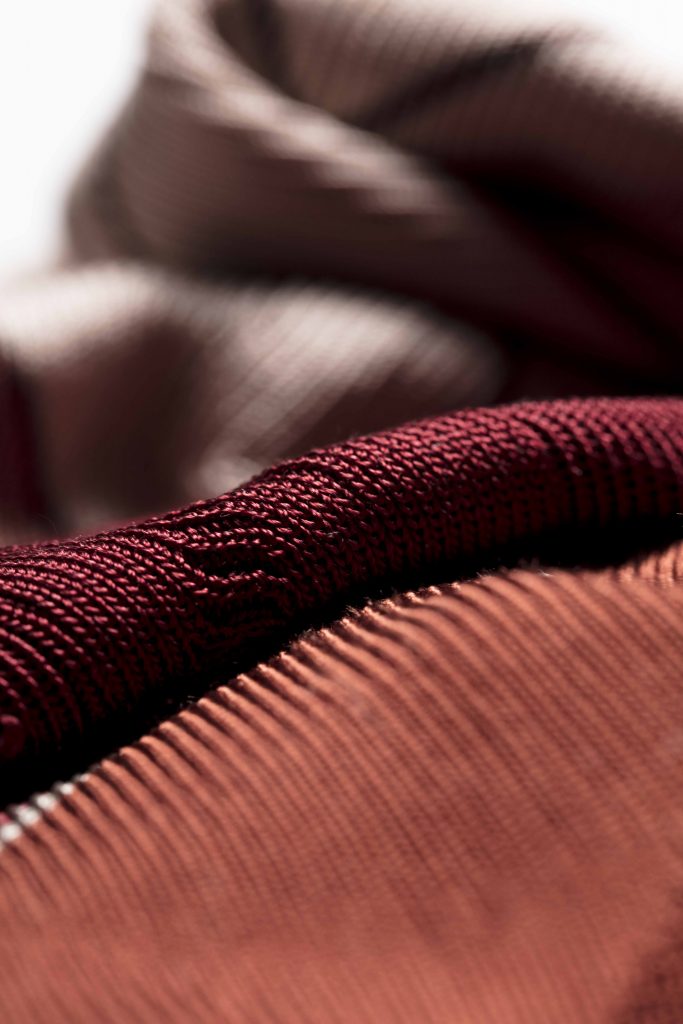Linking knitted garments requires dexterity and precision. A role fulfilled by craftspeople often with decades of experience, it is a fundamental stage of the construction of many knitted garments. The hands crafting the finished result by placing stitches individually onto needles and aligning pattern pieces with expert skill are responsible for the quality of the end product. As seamless knitting rapidly gains popularity, could this be the demise of the hand linker, and a loss of the years of generational experience that they hold?
Why Knit Seamlessly?
Polyester can take up to 200 years to biodegrade. With no petrochemical based thread required for over locking or reinforcing seams, and no double layers of fabric from seams, seamless garments from natural fibres biodegrade at faster rates. Particularly for sportswear and hosiery, seamless garments enhance comfort, durability and flexibility. With no ‘weak spots’ from seams, garments can endure more stretch and abrasion, and pattern designs can wrap around the body perfectly aligned, regardless of the market level.

The zero waste nature of the method aligns with goals to cut waste from the fashion industry. Fashion Revolution’s Fanzine No 003 states that ‘15% of fabrics intended as clothing end their life on the cutting room floor’. Cut and sew methods in knitwear can require a 15-20% waste margin. It is clear that more needs to be done to reduce waste in the production processes of clothes. Seamless knitting could be a solution to this- but at what other cost?
Seamless Knitting as an Instigator for ‘Even Faster Fashion’
Where the waste may be eliminated from the cycle, lead times in production could be cut and knitwear could become even more readily available. In our fast fashion market, is increasing availability really what we need? Where seamless knitting eliminates waste at the start of the cycle, it could merely redistribute the waste to the end. Fashion Revolution reports in their Fanzine no 0003 that 140 million pounds of clothing already go to landfill each year in the UK. Therefore, this rearrangement of waste rather than elimination of it could prove problematic.

What About the Value and Preservation of Tactility?
Passed from generation to generation, proficiency in hand finishing techniques can take years to perfect. This craft is a valued part of the knitwear production chain, creating jobs for many individuals, and allowing pristine quality control from human contact rather than machines. Seamless knitting removes this stage of production, and in doing so, removes the contact of human hands and the tradition of fully-fashioned garments. Valuing ‘who made our clothes’, see #whomademyclothes – an initiative started by Fashion Revolution. not only means protecting the human rights of garment industry workers, but also providing jobs and maintaining employment for people living in these industry focused areas.
Harley of Scotland however, are fighting this loss, by prioritising the perseveration of the original quality of hand crafted garments. Whilst relying on the generation-to-generation skills of their workforce for a variety of quality control processes, Milling processes and garment construction methods, they employ the benefits of seamless technology, reducing waste in their production cycles. Since 2001 they have been refining their methods, with their USP being ‘the perfect unification of our classic disciplines alongside forward-thinking seamless technology’.

So How Can the Heritage of Cut and Sew and Fully Fashioned Methods Coexist with the Innovation of Seamless?
Seamless knitting holds exciting potential for problem solving and reducing waste levels during garment production. The preservation of the craft of knitted garments, and the tradition contained within so many brands of hand crafted pieces, created by loyal, skilled individuals should be preserved and celebrated.
There is certainly a place for both cut and sew, and seamless methods within the knitting industry. Where one conserves the tradition of a craft, celebrating heritage, the other innovates and focuses on the future legacy. If well judged, this oxymoron could be the perfect alchemy for slow fashion, and the knitting industry could lead this journey to responsible, sustainable garment construction.

Subscribe To Our Newsletter
Join our mailing list to receive the latest news and updates from our team.






